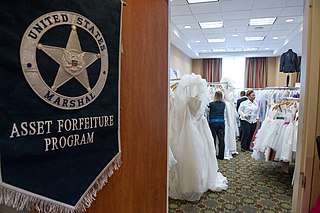Related Research Articles
In criminal procedure law of the United States, an exigent circumstance allows law enforcement to enter a structure without a search warrant, or if they have a "knock and announce" warrant, allows them to enter without knocking and waiting for the owner's permission to enter. It must be a situation where people are in imminent danger, evidence faces imminent destruction, or a suspect's escape is imminent. Once entry is obtained, the plain view doctrine applies, allowing the seizure of any evidence or contraband discovered in the course of actions consequent upon the exigent circumstances.
Section 8 of the Canadian Charter of Rights and Freedoms protects against unreasonable search and seizure. This right provides those in Canada with their primary source of constitutionally enforced privacy rights against unreasonable intrusion from the state. Typically, this protects personal information that can be obtained through searching someone in pat-down, entering someone's property or surveillance.
South Dakota v. Opperman, 428 U.S. 364 (1976), elaborated on the community caretaking doctrine. Under the Fourth Amendment, "unreasonable" searches and seizures are forbidden. In addition to their law-enforcement duties, the police must engage in what the court has termed a community caretaking role, including such duties as removing obstructions from roadways to ensure the free flow of traffic. When the police act in this role, they may inventory cars they have seized without "unreasonably" searching those cars.
Welsh v. Wisconsin, 466 U.S. 740 (1984), was a 1983 case before the US Supreme Court determining that a warrantless home arrest without exigent circumstances violates the Fourth Amendment protection against unlawful search and seizure.
United States v. Ortiz, 422 U.S. 891 (1975), was a United States Supreme Court case in which the Court held that the Fourth Amendment prevented Border Patrol officers from conducting warrantless, suspicionless searches of private vehicles removed from the border or its functional equivalent.

United States v. Brignoni-Ponce, 422 U.S. 873 (1975), was a case in which the Supreme Court determined it was a violation of the Fourth Amendment for a roving patrol car to stop a vehicle solely on the basis of the driver appearing to be of Mexican descent. A roving patrol car must have articulable facts that allow for an officer to have a reasonable suspicion that the person is carrying illegal aliens beyond their ethnicity. The Court handed down a 9–0 decision that affirmed the Circuit Court's ruling in the case. This case was also the final case that William O. Douglas presided on, as he retired shortly after this case, ending his record 36 years as an Associate Justice.
Schmerber v. California, 384 U.S. 757 (1966), was a landmark United States Supreme Court case in which the Court clarified the application of the Fourth Amendment's protection against warrantless searches and the Fifth Amendment right against self-incrimination for searches that intrude into the human body. Until Schmerber, the Supreme Court had not yet clarified whether state police officers must procure a search warrant before taking blood samples from criminal suspects. Likewise, the Court had not yet clarified whether blood evidence taken against the wishes of a criminal suspect may be used against that suspect in the course of a criminal prosecution.
Marcus v. Search Warrant, 367 U.S. 717 (1961), full title Marcus v. Search Warrant of Property at 104 East Tenth Street, Kansas City, Missouri, is an in rem case decided by the United States Supreme Court on the seizure of obscene materials. The Court unanimously overturned a Missouri Supreme Court decision upholding the forfeiture of hundreds of magazines confiscated from a Kansas City wholesaler. It held that both Missouri's procedures for the seizure of allegedly obscene material and the execution of the warrant itself violated the Fourth and Fourteenth amendments' prohibitions on search and seizure without due process. Those violations, in turn, threatened the rights protected by the First Amendment.
Kentucky v. King, 563 U.S. 452 (2011), was a decision by the US Supreme Court, which held that warrantless searches conducted in police-created exigent circumstances do not violate the Fourth Amendment as long as the police did not create the exigency by violating or threatening to violate the Fourth Amendment.
United States v. Mendenhall, 446 U.S. 544 (1980), was a United States Supreme Court case that determined "seizure" occurs when an officer uses displays of authority to detain a person.

Florida v. Jardines, 569 U.S. 1 (2013), was a United States Supreme Court case which resulted in the decision that police use of a trained detection dog to sniff for narcotics on the front porch of a private home is a "search" within the meaning of the Fourth Amendment to the United States Constitution, and therefore, without consent, requires both probable cause and a search warrant.
Missouri v. McNeely, 569 U.S. 141 (2013), was a case decided by United States Supreme Court, on appeal from the Supreme Court of Missouri, regarding exceptions to the Fourth Amendment to the United States Constitution under exigent circumstances. The United States Supreme Court ruled that police must generally obtain a warrant before subjecting a drunken-driving suspect to a blood test, and that the natural metabolism of blood alcohol does not establish a per se exigency that would justify a blood draw without consent.

In the United States, civil forfeiture is a process in which law enforcement officers take assets from people who are suspected of involvement with crime or illegal activity without necessarily charging the owners with wrongdoing. While civil procedure, as opposed to criminal procedure, generally involves a dispute between two private citizens, civil forfeiture involves a dispute between law enforcement and property such as a pile of cash or a house or a boat, such that the thing is suspected of being involved in a crime. To get back the seized property, owners must prove it was not involved in criminal activity. Sometimes it can mean a threat to seize property as well as the act of seizure itself. Civil forfeiture is not considered to be an example of a criminal justice financial obligation.
Birchfield v. North Dakota, 579 U.S. 438 (2016) is a case in which the Supreme Court of the United States held that the search incident to arrest doctrine permits law enforcement to conduct warrantless breath tests but not blood tests on suspected drunk drivers.
Timbs v. Indiana, 586 U.S. 146 (2019), was a United States Supreme Court case in which the Court considered whether the excessive fines clause of the Constitution's Eighth Amendment applies to state and local governments. The case covered the asset forfeiture of the petitioner's truck after the police found a small quantity of drugs within it and he was convicted on non-felony possession charges.
Mitchell v. Wisconsin, 588 U.S. ___ (2019), is a United States Supreme Court case in which the Court held that "when a driver is unconscious and cannot be given a breath test, the exigent-circumstances doctrine generally permits a blood test without a warrant."
Caniglia v. Strom, 593 U.S. ___ (2021), was a United States Supreme Court case related to the Fourth Amendment to the United States Constitution's "community caretaking" exception.
Lange v. California, 594 U.S. ___ (2021), was a United States Supreme Court case involving the exigent circumstances requirement related to the Fourth Amendment to the United States Constitution. The Court ruled unanimously that the warrantless entry into a home by police in pursuit of a misdemeanant is not unequivocally justified.
Nebraska v. One 1970 2-Door Sedan Rambler (Gremlin) 191 Neb. 462, 215 N.W.2d 849 (1974) is a Nebraska Supreme Court civil forfeiture case. It was brought by the American state of Nebraska to seize a Rambler Gremlin on the sole grounds it was transporting illegal marijuana. The owner appealed against the forfeiture decision on the grounds of a claimed lack of due process. The court ruled 4–2 and sustained the confiscation as lawful.

R v Stairs, 2022 SCC 11 is a constitutional rights decision of the Supreme Court of Canada. The Court established new standards for searches of a person's home after they have been arrested. At issue in the case was whether the traditional common law power of Search Incident to Arrest, which allows police officers to engage in warrantless searches of lawfully arrested persons, was compliant with section 8 of the Charter of Rights and Freedoms as it related to searches of the home.
References
- ↑ "South Dakota v. Fifteen Impounded Cats". Lowering the Bar. October 24, 2013. Retrieved January 17, 2020.
- 1 2 3 4 5 6 "State v. Fifteen Impounded Cats, 785 NW 2d 272". Supreme Court of South Dakota. June 23, 2010. Retrieved January 17, 2020– via Google Scholar.
- 1 2 3 "South Dakota Supreme Court Upholds Impounding Of Cats". Thenewspaper.com. Retrieved January 17, 2020.
- ↑ "SDLRC – Codified Law 40-1-5". South Dakota Legislature. Retrieved January 17, 2020.
- ↑ "Court: Officer was proper in seizing cats while woman drove". Rapid City Journal. Retrieved January 27, 2020.
- ↑ "South Dakota claw enforcement nabs 15 cats". Washington Times. June 27, 2010. Retrieved January 17, 2020.
- ↑ "State v. Fifteen Impounded Cats". Leagle. Retrieved January 28, 2020.